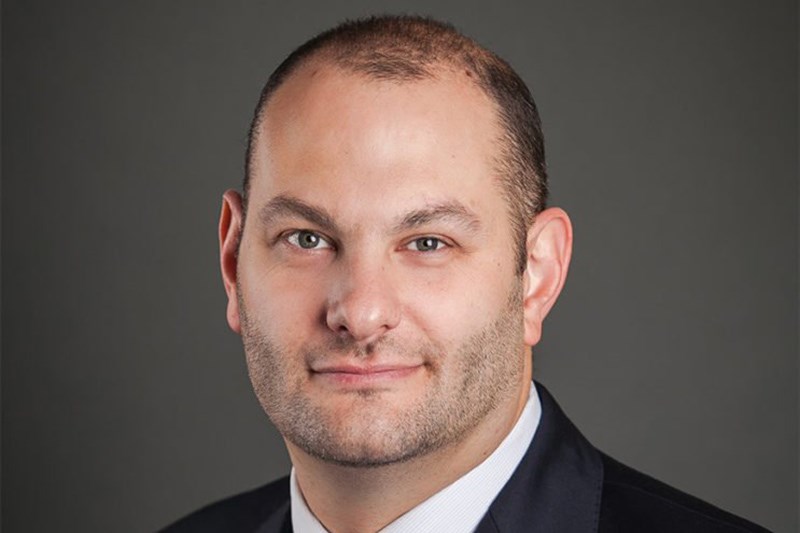The Crown and Const. Abram Letkeman’s defence lawyers presented their final submissions June 27 as the RCMP officer’s trial for manslaughter and other charges in the fatal November 2015 shooting of Steven Campbell concluded in Thompson.
Defence lawyers Lisa LaBossiere and Joshua Weinstein divided their duties between them, with LaBossiere addressing the two car collisions involving Letkeman’s patrol car and the Jeep Grand Cherokee that Campbell was driving.
The first collision, when Letkeman “bumped” the Jeep at the intersection of Caribou Road and Deerwood Drive, was permissible under Section 25 of the Criminal Code because Letkeman is a police officer and was trying to make a lawful arrest, LaBossiere said. It was at an empty intersection at 2 a.m. with the cars travelling at low speed, so there was little risk of serious injury to the occupants. She did agree with Court of Queen’s Bench Justice Chris Martin that Letkeman’s only defence on that charge could be that he is a police officer.
The second collision, on the ATV trail where Letkeman shot and killed Campbell, was, the defence argued, unintentional, as Letkeman was trying to box in the Jeep when it reversed into his path, according to the officer’s evidence.
“The context of a police officer has to be applied,” said LaBossiere, saying any mistakes that precipitated that collision should not be taken into account. “We need to look at the moment in which the force occurs.”
With regard to the shooting itself, Weinstein said it was justified by Letkeman’s role as a police officer and/or self-defence, as the constable believed he was in danger of being run over and killed.
“There was driver input, there was steering input,” Weinstein said. “Where Letkeman went, where he was moving on foot, so too did the jeep.”
Letkeman’s lawyers also pointed out that the Crown had not presented any evidence to refute Letkeman’s evidence that his right foot had been run over by the Jeep’s front tire shortly after he started shooting. Weinstein said there was no way the Crown could prove it wasn’t justified beyond a reasonable doubt or that there was evidence to show that Campbell had his hands up.
“There’s justification of the entirety of the shooting,” said Weinstein, arguing Letkeman shot Campbell because he had to, not because he wanted to.
Crown prosecutor Christian Vanderhooft said Letkeman was evasive, difficult and argumentative during his cross-examination and that he changed several details from what he had told the Independent Investigation Unit of Manitoba (IIU), which investigates complaints of on-duty and off-duty police officer misconduct, during a December 2015 interview. Letkeman demonstrated a continuing pattern of negligence throughout the entire pursuit of Campbell, he said.
“He rammed the vehicle to stop it and he had no business doing that,” said Vanderhooft. “It should have stopped there. It should have been over. That act was completely negligent. It’s quite simply dangerous driving.”
Letkeman’s testimony that he was trying to stop when he t-boned the Jeep on the ATV trail is inconsistent with what he told the IIU, Vanderhooft said, and even if Letkeman didn’t mean to hit the other vehicle, he still did so with enough force to break Lori Flett’s pelvis.
“A boxing in [to prevent a another vehicle from moving] is not done with one vehicle,” Vanderhooft said. “It’s extremely dangerous. He knows that officers are on the way. He should have stopped.”
The Crown prosecutor said Letkeman had decided before that second collision that he was going to exit his vehicle and arrest the driver of the Jeep at all costs.
“The series of decisions he makes next are completely reckless,” said Vanderhooft. “There was no need to approach that car. He knows they’re going to try to drive away.”
Vanderhooft also argued that when Letkeman fired his gun, he was no longer in any danger.
“He was out of the way and he continued firing,” Vanderhooft said. “His version that he was scared for his life is just not the truth. Physical evidence makes it clear that all shots happened when he was out of danger.”
Vanderhooft said the fatal bullet had to be fired through the Jeep’s driver’s window, by which point the tire would have already passed over Letkeman's foot, though he didn’t concede that Letkeman’s foot had been run over.
LaBossiere said in her rebuttal that inconsistencies between Letkeman’s statement to the IIU and his evidence at trial were mainly semantic and that there was no expert evidence of precisely where shots came from. She also argued that there was no evidence to suggest that Letkman put himself in front of the Jeep to give himself a reason to fire his gun.
Martin said he wanted to pronounce his decision before the end of summer and the parties agreed to hold that hearing Aug. 19 in Thompson.




